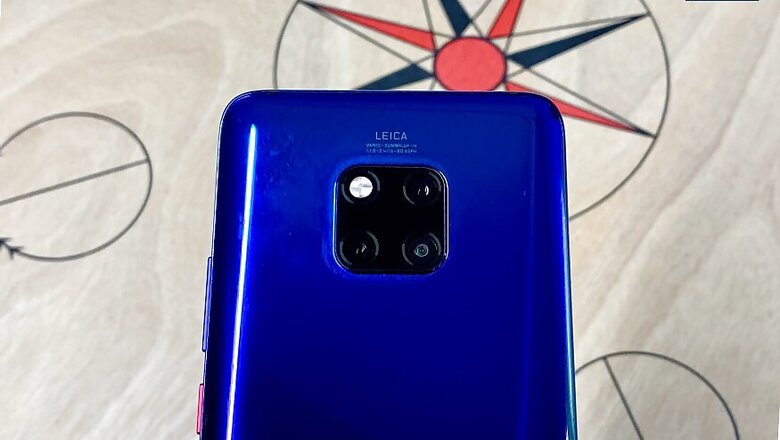Top 5 Android Camera Phones to Buy: OnePlus 6T, Xiaomi Redmi Note 6 Pro, Huawei Mate 20 Pro And More

views
Smartphones, it is now an expected norm, are supposed to have good cameras. At the moment, there are a number of phones that are simply superb when it comes to photography, while some are not as good. Despite megapixel counts and what not, not all phone cameras work the same way, and give the same quality of photos. Some phones really take the next step when it comes to photography excellence, because of a combination of factors, such as a great sensor, pixel size as well as the image processing algorithms and artificial intelligence working in the background to improve the photos that you finally see. Here are the best camera phones you can buy in India, right now.
Google Pixel 3 XL:
The Google Pixel 3 XL packs a 12.2-megapixel (f/1.8, 1.4-micron) primary camera on the rear. On the front, it packs an 8-megapixel (f/2.2) primary camera and a 8-megapixel (f/1.8) secondary camera. Google Pixel 3 XL smartphone was launched in October 2018. The phone comes with a 6.30-inch touchscreen display with a resolution of 1440 pixels by 2960 pixels. The Google Pixel 3 XL is powered by 2.5GHz octa-core (4x2.5GHz + 4x1.6GHz) processor and it comes with 4GB of RAM. The phone packs 64GB of internal storage that cannot be expanded.
The Google Pixel 3 XL is powered by a 3430mAh non removable battery. It measures 158.00 x 76.70 x 7.90 (height x width x thickness) and weighs 184.00 grams. The Google Pixel 3 XL is a single SIM (GSM) smartphone that accepts a Nano-SIM. Connectivity options include Wi-Fi, GPS, Bluetooth, NFC, USB OTG, USB Type-C, 3G and 4G. Sensors on the phone include 3D face recognition, Fingerprint sensor, Compass/ Magnetometer, Proximity sensor, Accelerometer, Ambient light sensor, Gyroscope and Barometer.
Huawei Mate 20 Pro:
The Mate 20 Pro is its triple rear camera system on the back that Leica-branded. Includes a 40MP wide-angle lens with f/1.8 aperture, a 20MP Ultra wide-angle lense with f/2.2 aperture and an 8MP telephoto lens with f/2.4 aperture. The cameras also support laser and phase detection auto focus as well as AIS (AI-based stabilisation). On the front, the Mate 20 Pro sports a 24MP 3D depth sensing camera.
The device sports a large 6.39-inch QHD+ (1440x3120) curved OLED display with a 3D glass on the front and back. The rear panel comes in a gradient Twilight, Emerald Green and Black colours. The device is powered by the company's latest Kirin 980 chipset that is based on a 7nm process and comes with dual NPU. It is also offered with 6GB of RAM and 128GB of internal storage with support for expandability up to 256GB via microSD card. The Mate 20 Pro offers an in-display fingerprint sensor and 3D facial recognition as biometric options.
The dual-SIM Mate 20 Pro houses a 4,200mAh battery with 40W SuperCharge support. The Mate 20 Pro also supports 15W wireless charging support and Huawei will be bringing its wireless charger to India as well. Connectivity options for the Mate 20 Pro include 4G LTE, Wi-Fi 802.11ac, Bluetooth 5.0, GPS, GLONASS and USB Type-C support.
Huawei P20 Pro:
The USP of the smartphone, however, is said to be its camera setup. This setup on the Huawei P20 Pro includes a 40-megapixel RGB sensor, an 8-megapixel telephoto sensor and a 20-megapixel monochrome sensor for enhanced low-light photography. The entire setup allows 5x hybrid zoom, background defocus effect and ISO 102400 light sensitivity which, as per Huawei, matches that on a Canon Mark 5D IV camera. The camera sensors also offer laser auto-focus, slow-motion (720p) video recording at 960 fps and Master AI for scene detection for optimum settings for an image. At the front, the P20 Pro comes with a 24-megapixel selfie shooter with 'Light Fusion' feature.
Huawei P20 Pro sports a 6.1-inch Full HD+ OLED display with 2240×1080 pixels resolution and 19:9 aspect ratio and a notch at the top. It is powered by a similar Kirin 970 octa-core SoC that also comes with a neural processing unit (NPU) for AI-based enhancement on features like selfies, video calling and face unlock. The smartphone comes with a 6GB RAM coupled with 128GB of internal storage. It is backed by a 4000 mAh battery with SuperCharge support. It also offers IP67 water and dust resistance.
Connectivity options on the Huawei P20 Pro include dual SIM card slots, Bluetooth, Wi-Fi, GPS and 4G VoLTE. It runs Android 8.1 Oreo with EMUI 8.1 on top and also supports Project Treble.
OnePlus 6T:
OnePlus retains the dual camera setup at the back, with the primary 16-megapixel camera and the secondary 20-megapixel camera. There is a 16-megapixel selfie camera as well. While OnePlus 6 sports a dual-camera module as its primary camera with one sensor of 16-megapixel with f/1.7 aperture and a supported camera module of 20-megapixel. The 16-megapixel camera now comes with Optical Image Stabilisation and EIS.
The highlights of the OnePlus 6T are that it now has a 6.41-inch display with the 19.5:9 aspect ratio, and this screen is larger than the 6.28-inch display sported by the OnePlus 6. The display type remains the Optic AMOLED type and has the 2,340 x 1080 resolution. The notch cutout on the screen has been significantly redesigned, is now much smaller and resembles the teardrop. There is now an in-display fingerprint sensor as well, which makes the 6T the first OnePlus phone to offer this feature.
OnePlus has completely refreshed the OxygenOS interface. This has been done to make it work better with the newest Android 9 Pie—but brings additional features to the table such as a Gaming Mode and a Smart Boost for even better performance. The battery capacity has been boosted to 3,700mAh (up from 3,300mAh in the OnePlus 6), and if we are to factor in the battery performance enhancements that the Android 9 Pie operating system brings to the table as it is, this could really return some impressive battery stats even with heavy usage.
Xiaomi Redmi Note 6 Pro:
Xiaomi Redmi Note 6 Pro features a 6.26-inch Full HD+ display with a pixel resolution of 1080×2280 and has an aspect ratio of 19:9. The smartphone’s display is protected by Corning’s Gorilla Glass. Powered by Qualcomm Snapdragon 636 SoC, Xiaomi Redmi Note 6 Pro is available in 3GB and 4GB RAM. The smartphone comes with either 32GB internal storage or 64GB of onboard storage. In terms of optics, the device houses four cameras.
The smartphone’s dual camera module at the back is comprised of 12-megapixel (f/1.9) and 5-megapixel(f/2.2) sensors with dual pixel autofocus. Up front, the smartphone houses 20-megapixel and 2-megapixel selfie cameras with AI portrait 2.0 selfie and Beautify 4.0. Xiaomi says the AI camera is capable of recognising scenes across 27 categories. Connectivity options on the Redmi Note 6 Pro include dual SIM support, Bluetooth 5.0, 4G VoLTE, and Wi-Fi. The device houses a 4000mAh battery.




















Comments
0 comment